 |
| Rickshaws in Chaotic Old Deli |
 |
| Rickshaw in Old Deli |
 |
| Shoe temple guardian |
 |
| Jama Masjid Mosque |
 |
| Jama Masjid Mosque |
 |
| Stupified in Old City Deli |
 |
| Contemplating – Jama Masjid Mosque |
Around the world with Marty
Wednesday, January 9th – San Francisco to London
I am sleeping lightly, waiting for the jolt of the alarm and sensing that I am catching a cold. For weeks everyone around me has been sick and I stubbornly refused to catch their bugs. There was simply too much work to keep up with during the Christmas season to even consider the luxury of a cold. Since the holidays, life has continued to be stressful as I checked things off the to-do list so that my 20 year old son John and I can make this trip to India and the UAE with a relatively clear conscious.
Art, John and I drive two cars up to San Francisco and leave John’s older Lexus at his house near S.F.S.U. We will return from our trip just one day before his semester begins so he needs to be settled in before our adventure begins. The three of us climb into our new Prius V and Art drives us to S.F.O. dropping us at the curb of British Airways. After the perfunctory curbside hugs and kisses, Art reminds John to “take care of your mom,” and John and I enter the revolving glass doors to the international terminal. Our flight is not for 3 hours and this part of the terminal is exceedingly quiet. John steers us to the nearly vacant, British Airways counter and I hand over our passports. The attendant who checks us in prints and tears off two luggage tracking tags and attaches one to John’s duffle bag and then another to John’s duffle bag. I wait for her to print out another tracking tag and when she does not, I point out that she has put both of the luggage tags on John duffle bag and none on my suitcase and she mutters apologetically explaining that she was distracted, talking. There is also some confusion concerning the terminal we arrive at in Heathrow London, versus the terminal we depart from. In London, our bags must make a transfer between terminal 4 to terminal 5 and I am less than optimistic that they will arrive in Deli with us.
London to Deli,
We have a 6 hour layover in London and we exit through customs to investigate tube and express train options into Covent Gardens. Our time is just a little too short, our energy level low and the weather is nippy so John and I decide to wait it out at the airport. We reenter the terminal and it takes us an hour to navigate our way to our departure gate at terminal 4, via glass habitrails, escalators and airport trains. We pass through security again and find ourselves once again in a maze of duty free shops and a melange of multinational transit passengers. It is late morning our time, but the overpriced airport restaurants are no longer selling breakfast and we decide that coffee is not a wise option with another overnight flight ahead, so we decide to adjust to London time and settle for an early dinner. John orders a club sandwich and I order fish and chips. John has a beer and I have a glass of wine. We continue wandering the terminal for another hour before John collapses prone on a stretch of benches at the far end of the terminal, backpack under his head for a pillow. I have trained him well. Our gate will still not be announced for two hours so it is up to me to sit vigilance, without dozing, lest we miss our flight. I find an internet area and shove 1 pound into the machine and manage to successfully log into Hotmail for 10 minutes and send mail home.
The flight between London and Deli seems longer than our flight between S.F.O. and London. Neither of us own a watch and with our smart phones on airplane mode, we float in limbo. Once in our seats, we each take half an Ambian and are asleep before the plane takes off. I vaguely remember the stewardess tapping my shoulder and asking if we want dinner but I grunt, decline and sleep. John is contorted into his seat, his lanky body a pretzel of discomfort. He is wearing his baseball cap with his hood pulled up over it and his face barely showing. He reminds me of a duck billed platypus. Some hours later, I wake, slip on my headphones and turn on my personal entertainment screen. I choose a Bollywood Movie to ease myself into consciousness and into the spirit of India.
Friday – January 11th. We Arrive in Deli
Indian customs is easy but the immigration attendant raises an eyebrow that our visas are good for 10 years. He comments that that must be a mistake and I smile and assure him that it is not; that we expect to have a wonderful time and be back again soon. The young couple, at the adjoining counter, are not having such an easy time of it; something is amiss with their paperwork. We are excited and rested and practically skip to the baggage claim where we wait anxiously, watching the revolving loop of suitcases hoping to soon be reunited with our luggage. Our bags are slow in coming and I try to reassure myself that since we checked in early at S.F.O. our bags would have been some of the first on and therefore the last off. Mine suitcase is eventually regurgitated from the shoot with John’s duffle following moments later. No one checks our tags when we exit the terminal but when we are finally at the hotel and unpack, I find a inspection tag inside my bag.
John spots the young Indian man holding the Mr. Marty and John Bobroski sign. (No “e” at the end of our name.) Navneet is wearing a suit, speaks perfect English and leads us towards the street with a jumble of taxis and cars waiting. He does not offer to help us with our luggage but approvingly comments that we are traveling lightly. He talks disapprovingly about the two women traveling from L.A. with 6 suitcases that he escorted earlier. Maneesh, our driver pulls up shortly and loads our bags into the back of a mini-van. The 30 minute drive into Deli is jammed packed with traffic with no regard for lanes or traffic rules. Horns honk, motorcycles slide through impossibly narrow spaces between cars and trucks and we pray that the golden temple deity secured to our cars dashboard provides protection.
The air is brown with pollution and our guide points out hospitals and military housing along the route, none of it very interesting to us. As we get closer into Deli, we note that the greenery along side of the road is well manicured and watered but a brown layer of pollution coats all the shrubbery and trees. We pull into the gated confines of the Royal Plaza hotel and the hotel security guards open the hood and the back hatch of our mini-van checking for explosives? We offload awkwardly, assisted by elegantly outfitted doormen and are motioned to put our luggage through an ex-ray machine. John, in his baggy jeans and hooded sweatshirt,is wanded at the entrance of the hotel but the door attendants put their hands together, fingers pointed upward, and bow slightly in a gesture of respect and motion for me to pass through.
 |
| Lobby of the Royal Plaza Hotel |
 |
| The Royal Plaza Hotel |
The hotel lobby is oddly magnificent with gleaming marble floors, gilded alabaster columns and a pseudo baroque ceiling with frescos of clouds and cherubs smiling down. A beautiful, young and elegantly dressed woman glides over to greet us and to escort me to one of the many check in counters where I hand over our passports and offer up a credit card imprint should we incur any extra expenses during our stay. Another hotel employee appears silently beside me with a tray of rose petals and anoints both John’s and my forehead with a smudge of red. After all has been duly recorded, Navneet escorts us to an alcove in the lobby where we sink into brocade couches and receive our travel documents; itineraries, train and plane tickets etc. We are on our own for this afternoon but tomorrow, we will be picked up by our driver Maneesh and an English speaking guide for an all day tour of Deli.
John and I shuffle behind as we are escorted to the elevators and up to our room on the 17th floor. She opens the door to a tiny room revealing two single beds, a desk and two chairs. A gilded mirror is along one wall, making the room look slightly larger, and the one window looks down to the street below. She asks me if the room is alright? I nod and comment that it is very small and she reminds me that this is the class of room that I have booked, smiles, and with hands together and fingers pointed upward, bows respectfully and exits. It is 12:00 P.M.
 |
| Trike traffic in the old city |
 |
| Trikes and tut-tuts waiting for fares |
John and I quickly shower off two days of travel dirt and plot our afternoon’s adventure. John wants to go on a walking tour of Old Deli that is recommended in the Lonely Planet guide book. The concierge tells us it is dangerous to go alone as does the taxi driver we hire to drive us to Chandni Chowk. 350 Rupees later we are deposited near the Red Fort. Our driver wants to wait for us and warns us of the dangers of Old Deli but we dismiss him and step out into the chaos of the streets. Dozens of tuk-tuks and trikes are jumbled together along-side the road all with drivers anxious for business. John and I are fare game and we are swarmed by drivers wanting to negotiate a fare. The green “trikes” seat two passengers above and behind the driver who peddles his passengers. The tut-tuts are three wheeled motorized vehicles, also seating two passengers but inside a canvas semi-enclosed interior. All is overwhelming and we are practically lifted up and onto a tricycle after agreeing on the price of 100 Rupees for a one hour ride. Several other drivers are arguing with our victorious “peddler” as he takes off with his bounty. Horns honk, pedestrians swarm, trikes and tut-tuts weave in and out of traffic and we hold on for dear life, laughing in the unfamiliar chaos. Apparently our young peddler has jumped on top of the feeding chain and our ride is abruptly cut short when two angry trike drivers stop him and we are quickly offloaded onto another trike to continue our journey down Chandni Chowk Street.
 |
| Traffic jam in the old city- Deli |
 |
| Traffic in the old city- Deli |
 |
| Old city- Deli |
All is visually intoxicating and the cacophony of horns and humanity exciting and unfamiliar. In all my travels, I have never experienced anything like this and John is more excited and happier than on his first trip to Disneyland. (I don’t really remember taking John to Disney Land, but I’m sure we did at some point; but we will always remember this day!) This is “Mr. Toads Wild Ride”, Deli style. We weave in and out of traffic; cars, trucks, taxis and pedestrians all competing for the right of way. I brace my left foot on a strut behind our peddler and hold on to the spindly steel frame of the vehicle with the other hand and take jiggly photos at the same time. Because of the congestion, the rutted road and all the vehicular and human obstacles, we are not going all that fast but it is a rough ride over the rutted road and there are seemingly no traffic rules.
 |
| Sari shop in the old city |
 |
| Ribbon and brocade shop in the old city |
The shops we are passing are draped with saris and packed with trinkets and we want to stop, look and walk some. I ask our driver to stop but he ignores me. and I ask again for him to stop and wait. Apparently he cannot, the pace of the traffic an incomprehensible torrential flow. He waves his arms indicating onward and to the left and tells us that he will take us around and behind this district, to a government craft store where we can look and shop. Visions of Egypt and China flash in my mind and I tell him firmly that I don’t want to go there. He continues to peddle, my emotions rise, and I call loudly to him, telling him that I will not go into a government store. In retrospect, I am probably rude and he stops abruptly and tells us to get out, that our ride is finished. We disembark, I pay him the 100 rupees, and our day unfolded magically on our own.
 |
| Stupefied in the Old City |
We are a in a bit of culture shock but John and I stick together and within a few minutes we feel more acclimated. We stride in pseudo-confidence along the narrow and obstacle ridden sidewalk teaming with humanity. My left hand grasps the strap of my back pack purse and my right hand holds my camera securely and John’s back pack is padlocked. To our right, between the sidewalk and the road is a 10-15 foot border; a jumble of long handled wooden push carts piled high with loads of strange good, construction debris and trash. Lethargic men of all ages and ethnicities, lounge atop carts or squat in groups in the dust; talking, smoking, eating or chewing beetle nut.
 |
| Workmen Waiting |
 |
| Electrical Wiring |
A narrow lane veers off to our left and we follow it. The street is 10-12 feet across and there is no motorized traffic but trikes weave around pedestrians and muscled men push the long wooden carts with towering loads of goods. The shadowed street meanders between ancient and crumbling, three story buildings blocking out most of the sunlight. Tiny shops are on street level, some just a few feet across. A darkened cement cave reveals a middle aged man sitting amid wood shaving and operating a wood lathe with his feet. Wood shaving fly and wooden bracelets are displayed in chains outside the doorway.
 |
| Wood turning shop |
 |
| Cart traffic in the old city |
There are tiny shadowed food stalls cooking unidentifiable fried foods and curries in huge black sizzling vats over wood stoked fires. We have not eaten for hours and with the time change, I am getting a coffee headache and my blood sugar is low. I watch a line of men drinking a hot milky liquid from one of the shops. We bravely step forward, order two cups, and a man, several steps down ladles boiling milk, half full into a paper cup and then pours a brown mixture of strong tea from a battered aluimnun tea pot. Other men are drinking this strong tea out of earthenware cups and I am relieved that ours have been served in these seemingly hygienic paper cups. I pay the man 20 rupees, the equivalent of 40 cents for both of our drinks, and we take leave. John takes a big slurp and burns his mouth with the boiling sweet liquid. I sip more carefully, enjoying the sweetness of the milky tea and hoping that the caffeine will take effect soon. We pass a series of “bakeries” where the cement floor is raised several feet above street level and young men squat over a recessed fire pit, pressing patties of nahn dough against the inside wall of a pit and removing the baked ones with tongs. We decide this seems like a safe food option and for 5 cents walk off with a steaming nahn wrapped in a piece of news paper. John and I tear pieces off as we jostle our way along the lane.
 |
| Chai Shop |
 |
| Baking Naan |
We spend many hours exploring these twisting alley ways chocked full of colorful sari’s jewelry, pashima scarves, religious plaques and statues of Hindu Gods and Goddesses as well as every day house hold goods. We find ourselves in a wholesale market for Indian bangles and ignore many an invitation to come in and “just take a look, not necessary to buy.” When pressured we run, but both John and I want to look at these colorful bangles and venture to step up and into one narrow show where we are not pressured or invited to come in. We spend 30 minutes looking bangles and exit $20 poorer but with two boxes filled with an assortment of several dozen.
 |
| John examining the goods |
 |
| Colorful bracelets |
 |
| Bracelet Bling! |
It is late afternoon when with our fuel level on empty, we know it is time to navigate back to our hotel. We paid 350 rupees for our taxi ride into Deli’s old town and expect the return trip to be the same. Several of the drivers demand 500 and we walk on until one driver chases after us and agrees to our 350 rupee price. His mini-van is parked off to the side of the road but is completely blocked by stationary busses and other seemingly immovable obstacles. Just as we climb onboard we hear drums and horns and realize that this central intersection, in front of the Red Fort, is the staging site for a political campaign rally. Music blares, floats roll past and people with rally signs parade across the intersection. 20 minutes later our driver manages to break clear of the congestion and we navigate slowly out of the old town and towards Cognaught Circle.
 |
| Traffic Jam in the Old City |
 |
| The Red Fort in Deli |
Cognaught Circle is in the new town and according to the map, not very far from our hotel, but the district consists of three major, concentric circular roads, with streets radiating through theses circles like the spokes of a wheel. In the center is a raised park with rabbit hole entrances leading to a subway system tunneling below. Above, street vendors sell piles of jeans and cheap clothing and we push through the chaos to the center of the park where I find a realatively clean wall to sit upon and can open my Lonely Planet guide book to get situated. John is sitting beside me and out of my peripheral vision, I am aware that a man is talking to him. Intentionally, I have put my “blinders” on, refusing to pay any attention to this persistent man while I focus on the guide book in hopes of finding a convenient recommendation for dinner in the area. When I look up several minutes later I am startled to see the man cleaning the wax out of John’s ears. He holds a flexible, 5 inch metal prod and triumphantly shows John a glob of wax that he has excavated. I question my son’s intelligence and street smarts allowing this man to insert a sharp and non-sterile instrument into his ears. The procedure finished, John pulls out $5 U.S. to pay the man for his services. Apparently, the ear cleaner has told John that he may pay whatever he wishes, but the man is not pleased with what John offers and opens a tattered “medical book” with charts and diagrams to show John the validity of his services. We make a hasty departure and later learn that the ear cleaning service costs usually $3-$4.
We set out in search of one recommended restaurant, but the circular streets confound us and we eventually settle for an upstairs Thai and Chinese restaurant with mediocre food and minimal atmosphere. We hire a tut-tut to take us back to our hotel, sign onto the internet to send e-mail home and fall into bed exhausted at 8:30 P.M.
Saturday, January 12th – Historical Deli
I wake hours before John and go downstairs to drink coffee and write this blog. I am graciously assured that it is “not a problem” if I drink my coffee now and return later with my son for breakfast. I sit and type and my waiter sees that my coffee cup is never empty.
I return to the room, collect John and at 8:30 we head downstairs for the buffet breakfast. The buffet is international and extensive, offering American cooked to order eggs and omelets, bacon and sausages, Korean noodles and spicy pots of vegetables, Indian curries, sushi rolls, fresh fruits, yogurts, cereals and an array of pastries and breads. In spite of the many options, I have seen this same spread at every 5 star restaurants between Egypt, Africa, China and now India. I choose fresh papaya, bacon and a potato lentil curry.
At 9:30 A.M. we are met by Navneet, who introduces us to our guide and driver for the day and quickly takes his leave. We drive in the direction of the Red Fort and Old Deli. Our guide has a heavy accent and is difficult to understand and does not know our itinerary? My printed itinerary is back at the hotel since I naturally assumed that our guide was briefed on today’s plan. He suggests various possibilities but I am frustrated since John and I do not know enough about Deli to make informed decisions.
 |
| Jama Masjid Mosque |
We begin with a visit to the Jama Masjid, India’s largest mosque, which accommodates up to 25,000 worshipers. The Mosque, built in 1656 and is constructed on a hill that rises above the old city. We climb a steep stone stairway up to the main gate, remove our shoes and deposit them with an ancient man, colorfully dressed and seated cross legged who will keep watch over our shoes for 10 rupees.
 |
| Courtyard – Jama Masjid Mosque |
 |
| Archway – Jama Masjid Mosque |
 |
| John taking Notes |
 |
| Arcade – Jama Masjid Mosque |
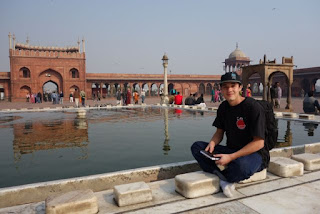 |
| Reflecting pool – Jama Masjid Mosque |
Our guide discourages us from wanting to visit the Red Fort and takes us instead to a 1000 year old Jain Temple down a side street. The façade doesn’t look like a temple but we climb up a few steps and enter through an open wooden door. Our guide hands us a printed sheet and we read the temple rules; no menstruating women may enter and no animal products are allowed inside. We take off our shoes, John removes his belt and I pass my leather purse to the attendant, seated cross legged on a raised platform with a ledger and pen poised. I take a calming breath and assure myself that my possessions and wealth will remain safe during this visit to the temple.
 |
| Painted Doorway beside Jain Temple |
 |
| Entrance to Jain Temple – Old City |
Barefoot, I climb ancient marble stairs feeling the stone chill beneath my feet. The temple is small but lovely and we peer into recessed mosaic shrines with smooth white marble figurines, honoring temple deity’s, each anointed with red smudges of color. After respectfully circulating the upstairs shrines, a temple attendant anoints our foreheads with a smudge of red, at the same time requesting a donation. I awkwardly pass him a 100 rupee note and we descend the cold marble stairs. My “purse guardian” is sitting vigil but when I go to claim my purse, he is firmly insistent that I make a donation to the temple. Apparently, the donation I made on the floor above was to the priest residing within the temple only.
 |
| John’s rickshaw ride – Old Deli |
 |
| Old City street scene |
We walk twisted alleys back to our two waiting tut-tuts and climb aboard. I ride solo in the first and John climbs into the tut-tut behind, alongside of our guide. We careen and jostle along crowded lanes clogged with humanity, cows, over-laden wagons and motorcycles.
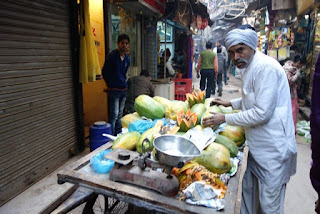 |
| Fruit Vender – Old City |
A political parade is marching along Chandni Chowk Street and the already crazy traffic is completely blocked. Music blares, people wave signs and a few floats move slowly on the opposite side of a barricade. Our tut-tuts cannot budge and after 20 minutes we get out and walk a kilometer to our waiting taxi.
 |
| Traffic Jam in the Old City |
 |
| Women pushing though crowds in the Old City |
 |
| Yesterdays Taxi Driver Friend |
We make a brief stop at the memorial to Mahatma Gandhi and listen to our guides spin on Gandhi’s life and his significance to India.
 |
| Memorial to Mahatma Gandhi |
Our guide suggests that we visit the Akshardham Temple, a temple with 20,000 carved deities. His English is hard to understand and it sounds impressive so we agree. What we didn’t grasp was that this is a new Hindu temple, completed in 2005. Because of terrorist bombings elsewhere in India, the temple is high security and we must leave purses, cameras, sim-cards and phones in the car with our driver. The grounds are not crowded today, but the temple is apparently packed on weekends and we cut through the line barricades that snake empty waiting for the weekend crowds. We pass through metal detector arch ways and at this point, men and women are separated and I am wanded and patted gently down behind a curtained area for women. The temple is immense, impressive and bewildering. Because of the unfathomable scale of this temple, I question if the sculptural facades might not be cast in plaster rather than carved out of salmon colored sandstone? Our guide insists that they are carved and I eventually concede but there are “clones” of the thousands of bas relief scultured elephants and deities frolicking along the façade of the temple. The interior of the temple is carved of white marble in giddying detail. All of the elements are in place for the making of a world wonder but I feel as if I am in Disneyland and am glad when we finally funnel through the immense gift shop, walk back along bridges crossing over pools with spewing fountains and traverse manicured garden pathways and back to our waiting car.
 |
| Purple and pink balloons at the Red Onion Restaurant in Deli |
We are starving and drive 40 minute though non-descript parts of Deli before stopping at the Red Onion Restaurant for a 3:00 P.M. lunch. The ceiling of this somewhat dingy, upstairs restaurant is decorated with pink and purple balloons and John and I are bewildered at the choice of this restaurant, lacking any Indian ambiance. In spite of the lack of promise, John and I remain in good humor and watch out the window as a workman on a 30 foot wooden ladder, held unsteadily by three men, repairs a tangle of overhead electrical wires. We pray for him, but also laugh and compare road and electrical repair work back in the U.S.A. and question the wasted man power of our system where two or three men are needed to simply hold caution signs. The chicken curry and broccoli dishes are surprisingly delicious and we forgive the bland atmosphere and the purple and pink balloons.
 |
| John and Marty – Qutb Minar |
 |
| Qutb Minar |
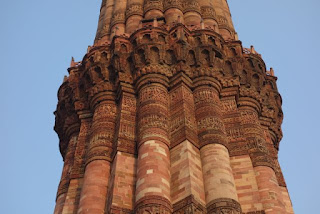 |
| Detail of Qutb Minar |
Refueled and revived we drive to Qutb Minar and the surrounding ruins of this 12th century victory tower. It is 4:00 P.M. and the late afternoon sun shines golden on this stunning architectural sight. The intricately carved, red sand stone minaret is 237 feet high and John is mesmerized and awed. His enthusiasm is catching and we simply want to be set free to explore but our guide drones on about the history in his difficult to understand English.
 |
| Column detail – Qutb Minar |
 |
| Bell column detail – Qutb Minar |
 |
| Minaret and Ruins – Qutb Minar |
Our impatience is obvious and our guide is insensitive to John’s energy and questions and continues to spout out well rehearsed data that we have little interest in. Eventually freed to explore, I follow John through arcades of intricately carved columns and through crumbling archways. I catch the fever of my 20 year old son’s enthusiasm and curiosity and I am joyful and present as we share these magical moments, exploring these ancient architectural wonders.
 |
| Visitors to Qutb Minar |
 |
| John exploring the ruins – Qutb Minar |
 |
| Qutb Minar |
The light is fading when we arrive at an overlook to the Bahai Lotus Temple, built in the shape of a blossoming Lotus Flower. It is nearly 6:00 P.M. and the temple is closed but our guide tells us this is the new “Taj Majal.” Even in the fading light, the temple is lovely and John makes a 5’ jump up onto a cement pillar, part of the fencing structure, wrapped in barbed wire. Our guide is taken by surprise which I am sure was partially John’s intention and John takes unobstructed photos of the Lotus Temple in the distance.
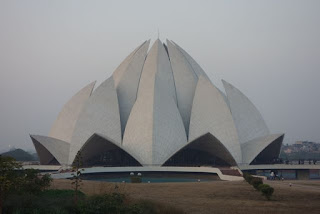 |
| Bahai Lotus Temple – New Deli India |
On our way back to the Royal Plaza Hotel, we make a stop at a the “market” which turns out to be a strip of “Government” owned tourist shops, each many levels high with dozens of lurking sales attendants. We exit 5 minutes later to look for our taxi and guide who have vanished under the assumption that we will certainly be inside and retained by pressuring sales attendants for a considerable time. We wander down the street and are invited into other multi level tourist shops with the enticing promise; “Just look, not have to buy.” I suspect that our guide is disappointed that we did not succumb to temptations within the shops since I have little doubt that the guides get commission from anything we might buy. We are dropped off at hotel and I tip both our driver and guide generously; but in retrospect, I rate the driver an A+ and the guide a C-.
After a few minutes in our room to refresh, John and I head out to find dinner but the directions we have been given by both our guide and the concierge are wrong. We walk briskly even though we have been told that this is a safe area to walk at night and there are many elegant hotels and guards promenading the tree lined sidewalk. A business man, obviously well to do and walking in the same direction as us, strikes up a conversation and informs us that the crafts market we are looking for has closed down due to construction. Construction barricades are directly ahead and he suggests that we go instead, to the Verda restaurant, off of Cognaught Circle. A lone tut- tut is parked at the curb on this darkened street and our new friend instructs the driver to take us to a night market, wait for us and then drive us to Verda restaurant. This will cost just 30 rupees, less than $1.
The market turns out to be another government shop but this time, the charming young man with a uni-brow, a fetching smile and good command of English, snares me. I see one tunic that I like and within seconds, he has unfolded and strewn dozens of others across the glass countertop. I know that he is asking too much for these monochromatic and minimally embroidered, “silk”, tunics and I try to bargain. He frowns at my low ball suggestion and the two caterpillars that form his eye-brows wiggle and he looks so crestfallen that I agree to the price of $14 each, hand over my credit card and we make our escape.
 |
| Verda Restaurant – Cognaught Circle |
Our tut tut driver is waiting loyally in front of the shop and drives us, seemingly in circles, to the Verda restaurant. The Cognaught Circle district is a series of concentric circular boulevards, cross-sectioned by other avenues and navigating the one way streets to the restaurant has its challenges. I am relieved we are not walking. A podium stands outside the entrance and we ask the attending woman if we may see a menu. It is expensive but the interior of the restaurant glitters invitingly and I do not have a backup plan. John and I are underdressed but we allow ourselves to be escorted to a table along the mirrored wall and I scoot into a quilted leather bench seat. John sits at the chair opposite me and we take in the ambiance of soft lighting reflecting off the mosaic ceiling. Venetian style glass chandeliers, lanterns and candles cast a warm light and lend a Bohemian charm to the bodacious décor. We are not all that familiar with Indian cuisine so John orders the tasting menu for about $25 and I order a single entrée of chicken curry for under $10. The service is impeccable and small plates begin to arrive at our table and we taste and share the various dishes. All is delicious but the cashew cauliflower is especially memorable and in we would have been filled and satisfied sharing only the tasting menu. In retrospect, I wish that I had taken notes on the various courses that we enjoyed so that John and I would have been better prepared for future meals in India. I enjoy drinking a glass of wine with my meals, but wine is not an affordable option in India so John and I share an Indian Kingfisher beer and relax into the magic of the evening.
Sunday, January 13th. Deli to Udiapur.
As usual, I wake before John, shower, dress quietly and leave the room to drink coffee downstairs and write. I slip into the dining room and request only coffee. My plans to write for an hour, sip coffee leisurely and return later for breakfast with John do not unfold when my computer will not start up. I return to the room, anxious and disappointed, but gratefully, my computer comes to life when I plug it in. Seconds later, Skype flashes on my screen and Tabra is calling! She noticed me online and I quickly push “accept call” and there she is! I arranged this trip to India via a friend of Tabra’s, and we talk excitedly for 15 minutes.
John and I head downstairs for the familiar and all inclusive buffet breakfast. He eats heartily but I am not very hungry; my cold is coming back and I feel slightly under the weather. We have several hours before we will be picked up and taken to the airport and the hotel pool beckons John. We sit outside in the courtyard and pass a leisurely hour. John draws and I write and sniffle but when the day begins to warm, John goes swimming. There are only a few guests seated at tables in the garden, and one young and pretty “au pair,” poolside, tending a 2 year old boy. The water level is even with the edge of the pool and John does multiple flips into the pool splashing and sloshing water over the edge. A Chinese couple takes photos of John, encouraging him to perform. He obliges and after many more flips he gracefully breast strokes several lengths of the pool. Two tables with business men feign disinterest, but I sense they wished they could be this free spirited and handsome American man-boy.
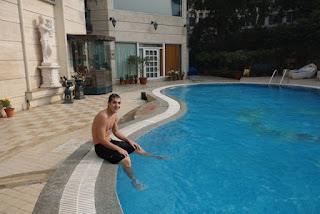 |
| John poolside at the Royal Plaza Hotel |
 |
| Poolside flips at the Royal Plaza Hotel |
The hotel is prepaid by voucher but I must check out and pay my internet bill. At 11:45 promptly, Nanveet and our driver Maneesh are there to transfer us to the airport. It is Sunday and the traffic is relatively tame and the drive to the airport uneventful. I tip our driver for his prompt and incident free driving and Nanveet, for his three days of service. Nanveet takes his leave at the entrance to the airport terminal because security mandates that no one can enter the terminal without a ticket and a passport. We show our documents and enter the airport to check in for our flight to Udipur. We are much too early but John is happy and energized and we wander the duty free shops for over an hour before settling down to eat a fast food lunch. John opts for McDonnalds and I pick the chicken out of a soggy sandwich and drink delicious mint lemonade. My cold is escalating but the mint lemonade makes me feel better. John and I write and draw until it is time to head to our gate. Boarding is quick but our plane delayed on the runway for over 30 minutes.
 |
| Deli Airport – Bronze Yoga Sculpture |
It is 4:15 p.m. when we land roughly in Udaipur, collect our luggage and are met and transported to our Trident Hotel, a 45 minutes drive from the airport. There are hundreds of trucks on the road as this is the main highway between Deli and Mombai. Most of the trucks are decorated with tinsel and garlands and there is the usual jostling for lanes between motorcyclists, trucks and cars. Most motorcycles carry two to 4 passengers and the saree wearing women, ride side saddle behind and without helmets. Often, one or two children are sandwiched in the middle.
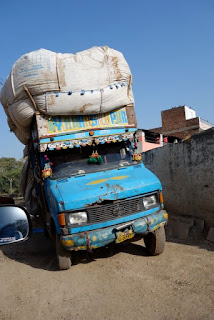 |
| Decorated and overloaded busses |
 |
| Family on a motorcycle |
 |
| Trident Garden Hotel – Udiapur |
 |
| View from an abandoned terrace |
 |
| View from an abandoned terrace |
We walk back to the hotel and John takes an evening swim before dinner. I am resigned to be “trapped” in the hotel for the evening and we wish to enjoy and luxuriate in our confinement. We peruse the drink menu in the hotel lounge and order two mojitos, the most reasonably priced drinks on the menu. Alcohol is very expensive in and heavily taxed in India but these beautiful drinks arrive in large Hurricane glasses with fresh mint and lime wedges accompanied by a dish of nuts and potato chips. The mint lemonade earlier today was a good tonic for my cold and this Mojito seems to cure it entirely. Our appetite abated, we head to the dining room, order lightly and eat an unmemorable chicken curry and cauliflower dinner.
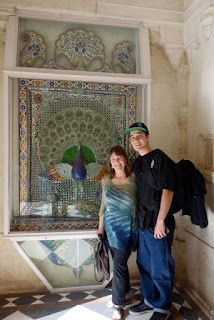 |
| Peacock mosaic – City Palace, Udaipur |
 |
| John and Marty – Peacock mosaic, City Palace, Udaipur |
Today, January 14th, is my Birthday.
I don’t sleep well and wake at 4:00 A.M. Today is my birthday and I get up at 4:30 A.M, shower and tiptoe out of our room to write in the reception lounge. John manages a sleepy “happy birthday Mom” as I leave the room. The lights in the lobby are dim and except for one doorman and two women waiting for a car to the airport, all is peacefully quiet. An impressive arrangement of lily’s emit a sweet fragrance and I can already hear the birds beginning to wake and call sweetly to each other in the pre-dawn. I sit and write for two hours and eventually follow the smell coffee to the dining room. The Trident is a new hotel, but the veranda promenade leading to the dining room gives the hotel the illusion and elegance of a classic hotel from a bygone era. Udaipur is further south in a semi-tropical zone and this garden hotel is an oasis of palms, bougainvilleas, acacias and banyan trees.
 |
| The Veranda at the Trident Hotel – Udaipur |
I wake John at 8:00 A.M. and we head to the dining room together for an exceptionally delicious buffet breakfast. Our driver and guide pick us up at 9:30 A.M. Although Singes’ accent is hard to understand, we like him immediately. He is well informed and listens and answers our questions rather than spouting off a memorized narrative.
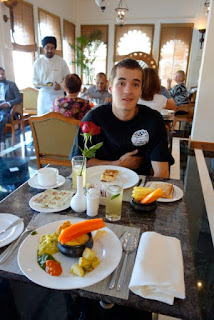 |
| Waking up to the breakfast buffet – Udaipur |
Udaipur is said to be the most romantic city in Indian and is often referred to as the Venice of the East. We begin our day with a visit the City Palace, a 17th century architectural wonder of excessiveness, constructed on a hill overlooking Lake Pichola.
 |
| The 17th Century City Palace – Lake Pichola, Udaipur |
The palace is a conglomeration of rooms, corridors, courtyards, terraces, balconies, towers, and cupolas. I am especially enchanted by an inner garden courtyard, framed by an arcade of ornately carved, scalloped archways with pierced stone and stained glass windows on the exterior walls.
 |
| The interior of the City Palace courtyard |
 |
| The interior courtyard arcade – City Palace, Udaipur |
The courtyard pool is unfortunately empty but the courtyard garden is magical, nevertheless.
 |
| John and Marty – The courtyard of the City Palace, Udiapur |
Every inch of the palace is ornately decorated and we tour mirrored rooms with mosaic ceilings and walk long corridors where the window coverings are pierced intricately in stone so that the women may look out but no one may see their faces.
 |
| Pierced stone windows – City Palace, Udaipur |
Other courtyards are encrusted with mosaics, the peacock motif being a recurring theme of opulence in intense blues, greens and gold.
 |
| Mosaic and mirrored room – City Palace, Udaipur |
 |
| Mirrored ceiling – City Palace, Udaipur |
A number of rooms in the palace are devoted to gallery exhibits of 10th century miniature paintings, amazingly detailed and color saturated. There are rooms filled with palanquins, others with ornate baby cradles and a weapon museum. This wedding cake palace is a visual extravaganza beyond imagination.
 |
| City view from the City Palace, Udaipur |
We stroll through the heart of the old town and I buy saffron at a spice shop.
 |
| Spice shop in Udaipur |
We walk through the vegetable market and I ask several of the women if I may take a photo and I am soon down on my knees sharing my photos with the women and the children in the market. Unlike many other markets that I have visited in third world countries, the produce here is beautiful and the women seem happy and are friendly to me.
 |
| Women at the Udaipur market |
 |
| Women and children at the Udaipur market |
 |
| Mother and Son |
 |
| Girl with her brother. |
John draws the attention of a group of young men and talks with them under the watchful eye of our guide. I imagine that our guide is instrumental in making these encounters happen easily and I appreciate his patience.
 |
| John with young men at Udaipur Market |
 |
| John making friends |
We make a brief visit to Saheliyon-ki-bari, the Ladies Garden, where I am approached by a vender selling camera batteries and memory cards. I have left home with just one battery and am thrilled to find this particular battery for $60, not very much more than it would have cost me back in the U.S.A. One water lily laden fountain with its guardian stone elephant sculptures is lovely, but the overall garden pales after our earlier visit to the City Palace.
 |
| Saheliyon-ki-bari gardens |
 |
| Elephant door handle |
We have lunch at an outdoor restaurant overlooking the lake. The lamb curry and chicken fried rice is not memorable.
Our guide is rather insistent in taking us to see how the miniature paintings are created and we find ourselves trapped again in a tourist shop. The initial demonstration is of interest and I learn that the natural pigments are ground from: blue:lapis, green:malachite, yellow:cow’s urine: white:zinc, black:lead, red:red ochre. The suave salesman is high pressure in a low pressure way and he reads me well because had he pressured me, I would have turned tail immediately. He engages us, showing us paintings and bronze sculptures priced far beyond our means and then subtly sneaks in a reasonably priced item now and again. His approach makes us feel as if we are in a museum not a tourist shop and as a result John and I stay for a long time. It takes all of my reverse sales “magic” to get out of there with our dignity and all our money still in our wallets. After exiting, we asked our guide to take us to another shop so that we can compare prices and quality on daggers, knives and bronzes. The second shop is such a sham and a turn off that we dismissed all thought of returning to shop number one.
 |
| Udaipur market stalls |
 |
| Boy at Udaipur market |
Our itinerary includes a late afternoon boat ride on Lake Pichola. I suspect that our guide is disappointed that we did not succumb to any temptations at the tourist shops and he suggests that we take an earlier boat ride. If I agree this will mean that he will be finished with us and his day will be over. Although he does not know that it is my birthday, I feel empowered and I do not want to be swayed. I ask to go back to the old town for a late afternoon walk. He is good at covering his dismay and exasperation and we enjoy a lovely hour strolling through the old town. John spies a tiny shop selling both framed and unframed images of Hindu deities and takes 30 minutes in choosing 50 – 75 embossed prints and spends less than $20. It is eye opening to realize the difference in pricing between the local stalls and the tourist shops.
 |
| Hindu deity print shop |
 |
| The skyline in Udaipur old town |
Sated with the old city, we get back in the waiting car and drive to the boat launch on Lake Pichola, beside the City Palace. I excuse myself and walk off to find a toilet and in my absence our guide mentions to John that, if he is interested, we can visit a knife manufacturer after the lake cruise.
 |
| The City Palace reflected in Lake Pichola |
 |
| Udaiper ghats |
 |
| Udaipur ghats |
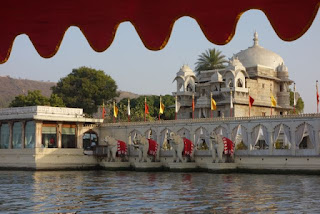 |
| Taj Lake Hotel and Restaurant |
 |
| Taj Lake Hotel and Restaurant |
 |
| Udaipur shops at night |
 |
| Rooftop view of Udaipur at night |
Returning to the knife shop, I wait patiently as John chooses and “bargains” for three knives. John eventually strikes his bargain for two ornate daggers and a sheath and knife. The man walks us across the street to a money exchange office and we wait while he goes off to find the banker to take our credit card payment. In the interim, his two boys play games on the computer. I try not to seem too anxious about my birthday dinner at the Ambrai Restaurant, close by and noted in the Lonely Planet guide book.
 |
| Merchants two boys playing computer games |
When the transaction is finally finished, we leave by tut-tut and jostle our way through crowded streets and over bridges to Ambrai. The candle lit restaurant is ambient with glittering views of the lake and the City Palace. We order two mojitos and several curry dishes, none of them remarkable. John hands me a hand drawn birthday card and tells me that I am the best mom ever. It has been a wonderful day and I feel happy and fulfilled.
We negotiated an 80 rupee tut-tut ride back to the knife shop where we wait for another 30 minutes for the leather sheath to make its appearance. I reclined and doze on a futon, against one side of the narrow shop, strewn with a half dozen of assorted and stained pillows. It had been a full day and I am ready to call an end to my birthday. The promised sheath is slow in coming and the merchant leaves John and me alone in his shop while he goes to fetch it from the leather worker. John is extremely happy when it is finally delivered and we thank the merchant sincerely, engage another tut-tut and return back to our hotel. I know that I am loved and today’s adventures have been wonderful. I could not wish for more.
 |
| Oasis |
 |
| Woman with water jugs |
The geology becomes interesting and our driver tells us that the rocks are sandstone, but John and I are fairly certain that they are shale. Signs warn of falling rocks and the hillside above is jagged with jumbled rock slabs. The road climbs higher and a gorge drops off abruptly on the left-hand side of the road. Monkeys sit expectantly on the low stone wall separating road from gorge, waiting for a car will pull over and the people inside to feed them human treats. I ask to pull over but our driver tells me that there will be plenty of Monkeys at the temple. Unfortunately, there are no monkeys when we arrive at the temple.)
 |
| Exterior of Ranakpur Jain Temple |
 |
| Inner Hall – Ranakpur Jain Temple |
Our tour company has arranged for a guide to escort us into the temple and a young man is waiting when we pull into the parking lot. His English is reasonably good, as is his knowledge, but he isn’t very charismatic and once again, John and I wish more to explore than to be lectured to.
 |
| Several of 1444 marble columns |
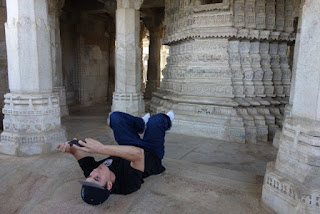 |
| John taking photos of a carved ceiling dome. |
This 500 year old temple is in pristine condition with 29 halls and 1444 carved marble pillars, no two pillars alike. John is awed and I my “Indiana Jones” son explores every hall and photographs nearly all of the 1444 pillars. He lies on his back on the cool marble floor to take photos of the intricate dome carvings overhead and leans precariously from a balcony window to take rooftop photos of the cupolas.
 |
| The view look up into a dome |
 |
| John taking photos of the rooftop cupolas. |
 |
| Monk at Ranakpur Jain Temple |
| Bas Relief Detail – Ranakpur Jain Temple |
I have traveled extensively and I am sometimes jaded by “just another temple”, but this temple is exceptional and it is wonderful to see it through John’s eyes. He tells me it is the most beautiful building he has ever seen. We closely examine the detailed carvings throughout and it is a unique panel of 5 goddesses wearing a multi-cobra twisted head dress that most amazes me.
 |
| “Cobra” Goddess Mandala |
 |
| Detail of the “Cobra” Goddess Mandala |
We have a simple lunch at a nearby restaurant and John, tired of the curry dishes, orders a toasted cheese sandwich and French fries. (He will regret this later.) I order a tasty bowl of mixed vegetables and we share a Kingfisher beer.
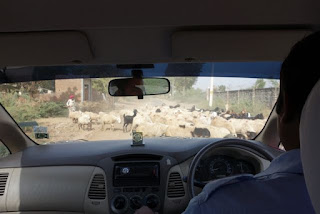 |
| Goat and sheep traffic jam |
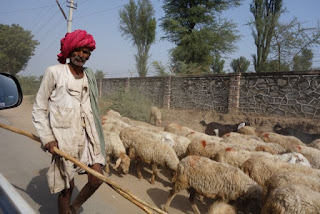 |
| Sheep herder |
The drive has been, and continues to be harrowing and we still have a three hour drive before we reach Jodhpur. The mini-van is in good repair and our driver is competent, but very aggressive. Earlier this morning, he joked that to drive in India, one needs three things; a good horn, good brakes and good luck. We are sharing this badly paved two lane highway with hundreds of “Goods Carrier” trucks, transporting handicrafts and construction material between the major cities. The “Goods Carriers” are 8 wheelers, brightly painted and decorated with fringes and tinsel and an occasional tassel. Many have names painted on the fronts of the cabs. Tut-tuts, motorcycles, goats, cows, camels and humanity also traffic this road.
 |
| Men walking along the roadside |
 |
| A parade! |
Our driver has no qualms about passing slower traffic when clearly, a “Goods Carrier” is barreling straight at us, goats are ahead in the road and a motorcycle with an entire family sandwiched onboard speeds beside us and a truck loaded with tens of thousands of pounds of uncovered blocks of marble is also competing for road space.
 |
| An uncovered load of quarry stone |
At 5:00 P.M. we arrive at the Ajit Bhawan, a 5 star hotel on the outskirts of Jodhpur. On route, our driver asks hopefully, if we will be having dinner at the hotel? (This will mean that he will be off for the evening.) I tell him that we won’t know our plans until we see our hotel but that we can take care of ourselves and take a tut-tut into town and back to the hotel on our own. This plan changes at check in when our tour company liaison greets us and informs us that it is not safe to go into the old city alone at night and that he will arrange for a guide and our driver to escort us.
The grounds and the hotel are lovely but artificial and we know that we do not want to be trapped here for the evening. We are escorted along a winding rock pathway to our room. As we walk to our room we pass through the dining courtyard where turbaned waiters in white tunics, light torches and prepare fires in raised cauldrons throughout the patio. Arriving at our room, our hostess unlocks a heavy brass padlock to the massive wood hewn door of our room. We have 30 minutes to “relax” before our escort into the old city. John showers quickly and we explore the hotel grounds. Our room backs up against the hotels stables and an outdoor kitchen. Two young men are baking naan in an open fire pit, on the rooftop. They offer us freshly baked naan to feed to the cows and a well groomed pit bull runs up and nuzzles John.
 |
| Jodhpur market at night |
 |
| The Jodhpur clock tower |
Dusk is settling in when we reach the old town. Our guide walks with us down the market street, crowded with pedestrians, tut-tuts and motorcycles.
 |
| Tut-tuts waiting for a fare |
 |
| Jodhpur spice shop |
We pass by many spice shops, barrels filled with dried red peppers and baskets piled artfully high with cone shaped towers of ground spices. I stop to ask about a pile of brown chunks and the vendor smiles and breaks off a piece with his dirty hands, offering it to me. I take a bite of the sweet brown sugar and I ask if I may take a photo. He grins and I show him the photo in the back of my camera. A fruit vendor grins at me and hold up clusters of grapes. He is delighted when I show him his image captured in my magical camera.
 |
| Beautiful grapes! |
 |
| Happy, night market fruit vendor – Jodhpur |
We pass along shops crammed with mirrored fabrics, colorful bangles, brass figurines as well as tiny stalls selling galvanized hardware, tires and automotive parts. Groups of men gather smoking and eating, at the edge of the street around small fires. The bright lights of the crammed, cluttered and colorful shops make the experience very magical.
 |
| Kitchen ware shop – Jodhpur |
 |
| Lassi shop – Old City, Jodhpur |
I sense that our guide is not delighted with this addition to our itinerary but he dutifully leads us into a covered vegetable market. Wooden carts are laden with piles of cauliflowers, eggplants, lettuces and every conceivable fruit or vegetable. The market is busy and our guide explains that at the end of the day, the prices go down for the fresh produce. The produce is beautiful, certainly many times better than what one might buy at a chain supermarket in California and I wonder if it will not be just as enticing in the morning.
With the exception of breakfasts, our meals are on our own and I want to go to Nirvana, in the heart of the old city and recommended in the Lonely Planet guide book. We know where our driver will be waiting and our guide points to a stone stairway leading up to the restaurant and leaves. John and I climb the stairs and cross through a courtyard and up another flight of stairs to the rooftop restaurant. The restaurant shares the premises with a Rama temple and is strictly vegetarian.
 |
| John at Nirvana restaurant – Jodhpur |
 |
| Near abstract photo, looking down upon the night market |
The night-time view of the Rajput-Mogel fort is spectacular but the food is mediocre and greasy. The fresh lime spritzers, served in a glass, ¼ filled with fresh squeezed lime juice accompanied by a bottle of soda water and a small pitcher of sugar water are delicious. It is 7:00 P.M. and the Muslim call to prayer echoes eerily throughout the city. A loudspeaker, positioned atop a nearby building projects the prayer loudly in our direction and when this chant ends others prayers begin, overlapping and harmonizing and the night is filled with an unfamiliar music. Although the food is not great, the city view is stunning and we enjoy the concert. Our bill for the two of us is less than $7.
John and I navigate the few short blocks through the streets of the old town alone, to the clock tower square where we know we will connect with our waiting driver. He is relieved to see us and swoops us into the cocoon of his waiting car and transports us to our boring but safe tourist hotel.
Our room is very smoky, presumably from the roof top fire pits and I sleep poorly. I learn in the morning that they also burn the hotels garbage out behind our section of the hotel.
Wednesday, January 16th – Jodpur City to Manvar Desert Camp
After the usual hotel breakfast and fueled with several cups of extremely strong coffee, we meet our guide and driver for our morning tour of Jodpur. Our driver maneuvers through the chaos of the old city and uphill towards the Mehrangarh Fort.
 |
| View of Mehrangarh Fort |
 |
| Jaswant Thada |
Our first stop is at the Jaswant Thada, a palatial memorial and garden honoring Rajasthan royalty. It is an active cremation site with views of the Fort above and beyond and our guide explains that for the Hindu, cremation returns the body to the 5 elements, air, sky, water, earth and fire.
 |
| Jaswant Thada Ghats |
 |
| Royal Cenotaph Cremation Site |
Our guide waits outside while John and I remove our shoes and climb the steep stone stairway to the memorial. The cold of the marble floors is chilling but the visual warmth of the translucent light streaming through ornate pierced stone and windows is lovely.
 |
| Jaswant Thada guard reading in the morning sun |
 |
| Pierced marble window detail |
 |
| Detail of the doors |
The road ascends higher to the Mehrangarth Fort, a massive stone fortress that sits sentry above Jodpur. Parts of this 15th century fort are the current residence of Rajasthan royalty but visitors are allowed to tour much of the fort and the museum exhibitions. We ascend to the battlement by elevator and take in the views of Jodpur City, a jumble of blue block cube houses, clinging to the hillside below and beyond.
 |
| Jodhpur City view from Mehrangarh Fort |
 |
| Exterior detail of Mehrangarh Fort |
The buildings of the city below all have flat topped roofs and our guide tells us that the rooftops are used for sleeping during the hot summer months. I am struck by how neat and clean these spaces appear, unlike in Egyptian cities where the roof tops views I recollect were cluttered with rubble, garbage and innumerable satellite dishes.
 |
| Jodhpur – The blue city. |
We spend the next two hours touring the public rooms, courtyards and exhibits within the fortress. The architecture is a mixture of Hindu and Muslim influences with scalloped windows and intricately carved shutters and pierced stone window coverings.
 |
| Woman sweeping – Mehrangarh Fort |
 |
| Interior courtyard – Mehrangarh Fort |
As in all the palaces and forts there are rooms for the men with open windows and balconies overlooking the courtyard below and sequestered chambers for the wives and concubines.
The windows in the woman’s quarters are ornately pierced of stone so that they may see out but no one can see in and the woman’s quarters are lack balconies.
 |
| Guard leaning out ornately carved windows |
 |
| Stained glass reflections |
Various rooms house exhibits of palanquins, baby cradles, miniature paintings, textiles and weapons. John and I focus on the details of the metalwork and sculptural accents at the ends of the palanquins and knives.
 |
| Peacock Palanquin |
 |
| Elephant sculpture on knife |
As remarkable as the miniature paintings are, we are beginning to tire of these and circulate the painting galleries quickly. Our guide is knowledgeable and patient but notably surprised and perhaps a bit disappointed with our quick exit of the gift shop.
 |
| Peacocks crowning a babys cradle |
 |
| Gilded and mosaiced ceiling detail |
Although we enjoyed last night’s visit to the market we are not sated and we ask to walk down from the fort into the old town so that we may experience the city in the daylight.
 |
| John and our guide walking the ancient rode into the city |
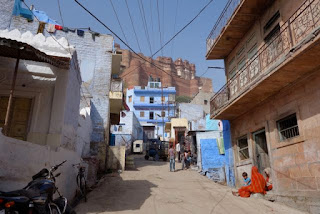 |
| View up the street to the Mehrangarth Fort above |
The ancient street, winding down from the fortress is constructed of age polished blocks of uneven stone. I carefully pick my way down the street lest I slip or turn an ankle. John, true to form, bounds 5 feet up onto the ancient 2’ wide, stone wall that follows the curve of the road and drops down many feet to the town below. I cannot see above and below this high wall but both our guide and I caution and beseech John to come down. A few twists and turns later when the wall deteriorates to an unmanageable jumble of stones, John jumps down and walks beside me on the ancient fortress road.
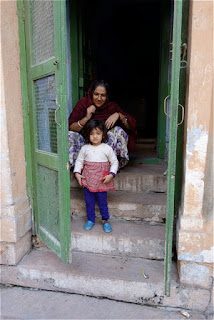 |
| Woman with child |
 |
| Jodhpur – The blue city |
The road winds between the jumble of blue block buildings that we had viewed from above and it is fascinating to peek into ancient doorways and to imagine the lives lived within. Wide eye children stare curiously at us and half veiled women watch us suspiciously.
 |
| Men passing time |
 |
| Man sitting |
Men squat at the side of the road and young men gather in groups, arms around each other and cell phones in hand. The men and boys are not afraid to ask where we are from and to shake our hands.
 |
| Women seen through abandoned Tut-tut |
 |
| School boys going home in a Tut-tut |
The main market square of Jodhpur City is bustling but unfortunately, we have only a few brief minutes to take in the colorful chaos before heading to lunch and driving to Manvar Desert Camp.
 |
| Sardar Market Square – Jodhpur |
 |
| Locksmith merchant |
 |
| Mother and child |
 |
| Street child |
After lunch at On The Rocks, a touristy garden restaurant, we get back in the car for a 2 ½ hour drive to Manvar Desert Camp. The road show is always interesting and we pass two camels pulling carts piled high with black plastic water cisterns. They trot down the highway, sharing road space with horn honking, “Goods Trucks” and the usual mixture of motorcycles, livestock and humanity. The loads are twice the height of the camels and I wonder how often the large cisterns break free and roll down the highway, creating even more havoc on the road way.
 |
| Camel pulling cart with plastic water tanks |
 |
| Goods Truck hauling uncovered quarry rock |
 |
| Colorful “Goods Trucks” |
I touch type and look out the window as city turns to countryside and the countryside morphs to scrub desert. The day is sunny and bright and the desert landscape is dotted with thorny bushes and cactus. Interspersed in the desert landscape are occasional patches of green where irrigation turns the desert into farmland.
 |
| Manvar Desert Resort |
The Manvar Resort is like any of the 5 star hotels, an enclave of lush gardens and courtyards and a pool with pale tourists reclining on poolside lounges. John and I are at the resort for just long enough to drink a welcome hibiscus tea and register our passports and credit card before transferring into jeep that will take us to the tented camp.
 |
| Jeep tracks |
Our driver and a Manvar Camp host, ride in front and John and I ride, without seatbelts, in the open back. Initially, we backtrack down the paved road before turning onto a dirt road for a 1 ½ hour desert tour. The jeep slides down some very steep and sandy embankments and we see many antelope and gazelles grazing in the scrub desert terrain. The largest of the antelopes is an impressive and stocky nilgai.
 |
| Sliding down the embankment – Antelope below |
 |
| The large Nilgai Antelope |
Our driver does a good job at giving us a memorable jeep experience but as a geologists’ daughter, this jeep safari is tame. I have read about this desert area and am not expecting sand dunes but when we come to a series of small dunes, our driver stops. We walk barefoot in the sand and John does back flips off the inclines of the sand dunes. I think that I am taking a movie of his acrobatics, but unfortunately, I use the wrong camera setting throughout the trip and return home with only still shots.
 |
| John does back flips on the sand dunes |
Our “tour” is to include a visit to a desert village. We stop at a family compound and are ushered inside the walled courtyard. I feel that we are intruding but we have been told that it is the visits from the tourists that help to sustain these families and our guide explains that they alternate visiting different family compounds so that no one group is overly disturbed or gets all the tips.
 |
| Family Compound |
 |
| Inside the courtyard of a family compound |
The hard packed dirt courtyard is immaculately swept and there are three thatched round adobe huts built along the inside perimeter of the walls. We peek inside the largest and I am pleasantly surprised to see the tidy and efficient arrangement. Colorful clothing is draped over a long pole that crosses the room and mattresses are piled to one side and neatly covered. Three suitcases are tucked into a recessed alcove and a few pictures are arranged on a shelf. Another of the huts is outfitted as the kitchen and black iron cooking pots sit on an extinguished fire pit and dry goods are stored in a recessed alcove.
 |
| The sleeping room |
 |
| The cooking room |
The small children watch us curiously but the mother is standoffish and keeps her face covered with a veil. No one speaks and two young women, possibly John’s age, stare solemnly at him. Before hand, our guide suggested that we give the family a small amount of money so I hand the mother 20 rupees and John pulls pens and candy from his backpack to give to the children.
Our guide asks us if we would like to visit a blacksmiths shop and my interest peaks. The blacksmiths compound, along a rutted dirt road, is built on a small rise. We stoop to enter a round adobe thatched hut where an elderly man crouches on the dirt floor beside a wood fire. His wife (presumably) squats against the wall spinning a bicycle tire connected to a belt that spins a smaller wheel that is rigged to blow air into the coals to heat them to a glowing red.
 |
| Blacksmith |
The man is forging a steel rod into a tool and alternates between heating the rod in the coals and pounding the glowing red metal on a rock to shape it appropriately. A young boy, silhouetted dark against the bright afternoon light, watches from the doorway. John squats beside the man to see more closely as the man repeatedly heats and forges a crude iron tool. He then proceeds to put tobacco and coals from the fire into a short ceramic cone shaped pipe.
 |
| John and Blacksmith with pipe |
He tips his head to one side and keeping the pipe vertical inhales several times and passes the pipe to John. John tries to duplicate this maneuver but when he bends his head to get below the mouthpiece, the pipe tips at a 45 degree angle. The glowing coals threaten to fall onto John’s shoes and the man’s bare feet and our guide steps quickly forward to prevent disaster and John manages an awkward inhalation or two. The pipe is offered to me but I decline. In the interim, a basket of shiny brass pipes has mysteriously appeared on the bench beside me and I presume that the family is hoping that we will purchase one but strangely, no mention is made of this. As we leave, I tip the man 20 rupees.
Beautiful children carrying baby goats along the road.
 |
| Boy and girl carrying baby goats |
 |
| Girl with baby goat |
It is late afternoon when we arrive at our tented camp for the night. We are in tent number one, on the uphill edge of this gently sloping desert camp and closest to the main dining tent. A precise semi circle of over 30 permanent canvass tents, defines the perimeter of the camp.
 |
| Manvar tented camp |
We are delighted to be here although both John and I were hoping for a more authentic and rustic setting. Inside the large, open fronted dining tent, waiters are setting the tables and readying a flat topped wooden wagon into a bar on the sand beyond. A semicircle of cushions with low tables curves around a large circular cement stage where we will presumably sit and watch the evening dance and music performance. Our tent is lovely with twin tapestry covered beds and a private bathroom off the back. The fading afternoon light casts a warm glow through the orange and yellow tapestry walls at the heads of our beds.
 |
| Tent interior – Manvar tented camp |
The temperature is dropping and John turns on a small space heater which warms the interior quickly but I question the safety of this and wonder how quickly we will be able to unzip the tent in the event of a fire.
 |
| Playing cards together |
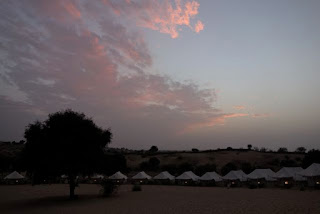 |
| A desert sunset at Manvar Tented Camp |
The jovial French tour-group, begin to choose stage side seating in anticipation of the evening performance and John and I take cushioned seats and wait.
 |
| Stage side seating in the sand |
I am not a fan of these touristy music and dance performances but I have alternately enjoyed and suffered through many on my travels. Tonight’s performance is the worst. There is no sound system and no stage lighting and the music is barely audible in the vastness of open night air. What we can hear is tinny and amateurish so the lack of amplification may have been a blessing. Waiters circulate with trays of appetizers and John and I talk and nibble. Although we are disappointed with the quality of the performance, we enjoy ourselves nevertheless.
 |
| Twirling dancers |
John obliges when a young male performer approaches him, nearly pleading that he come onstage and dance the grand finale with them. A dozen drunken French tourists, John and a few gypsy dancers form a conga line and twirl awkwardly in the light of the small flickering fires.
 |
| Dancing French tourists, Gypsy dancers and John |
 |
| Conga line at Manvar Desert Camp |
The performance over, the dancers set a narrow lipped vase at the edge of the stage but make no mention of tips or the purpose of the jug. I expect the French tourists to take the lead and deposit tip money into it but when no one does, John and I slink off and up to the dining tent without leaving a tip.
My conversational French needs much practice so John and I sit alone at a table for 4. The dining tent is lit only by lanterns and candles and a dozen covered and heated casserole warmers line the buffet table brimming with the expected assortment of curries, rice, vegetables, lamb and chicken and naan. The food is passable but not memorable and with another full day accomplished, we trudge off towards tent number one, just below the dining tent and fall asleep to the pleasant chatter and laughter of the French tourists.
Thursday, January 17th – Manvar Desert Camp onto Jaipur
The chatter and laughter of the French tourists at 6:00 A.M. is not quite as pleasant as it was last night. John curses and pulls a pillow over his head but our alarm is set for 6:30 and I rouse him shortly so that we can take a sunrise camel ride before breakfast. We down quick cups of coffee before trudging, through the sand, towards two waiting camels.
 |
| John and Marty atop a dromedary camel |
We are hopeful that we will each get a camel but camel number two is reserved for other guests and John and I ride together. Our dromedary, (one humped) camel, is colorfully outfitted with tassels and a tapestry blanket and we both climb aboard awkwardly. Two years ago, I traveled to Egypt where I was chosen to be one of 8 camels riders for a two day documentary filming of the Frankincense Trail; an infomercial for Young Living Oils. I adore these amusing beasts and am not a novice at camel riding. John sits in front and our “ship of the desert” lunges forward and then rocks backwards as it rises to its feet.
 |
| Morning camel safari |
The camel driver, a slight elderly man wearing loose fitting white cotton pants and kaki jacket, leads our camel out of the camp and into the desert. The soft gray morning light is lovely and John and I laugh as we adjust to the unfamiliar sway and rocking of the camel’s gait. Our guide leans forward to gain traction in the sand as we mount a small hill. We too lean forward to center our weight and to prevent sliding off the back and I tell John about a fellow camel rider in the filming of the Young Living, Frankincense Oil film, who’s saddle came uncinched and who slid and tumbled off his lofty beast and onto the dunes.
 |
| Women looking out |
 |
| Family compound |
 |
| Morning view of Manvar Tented Campsite |
 |
| John and our camel driver |
 |
| Bedroom Camel Eyes |
The French tourists are gone and the breakfast buffet is sparse and picked over and the instant coffee is tepid. Nevertheless, we have had a fun Disneyesque desert camp experience.
At 10:00 A.M. we climb into the back of the jeep to return to the resort. There are children going to school and when the jeep slows to allow goats to cross the dirt road, several children run up along side of our jeep. John is in the process of giving pens and pencils to the children but our driver is not aware of this and pulls away quickly before John can distribute all of the pens pencils. John tosses a handful of pencils out the back of the jeep and a dozen children run excitedly towards the treasure. In retrospect I worry that some of the children may have picked up a handful and others gotten none.
It’s not quite a 2 hour drive back to Jodhpur and we make it without incident. I type most of the way, no longer as anxious over passing vehicles in the presence of head oncoming traffic.
 |
| Jodhpur Old Town in the rain |
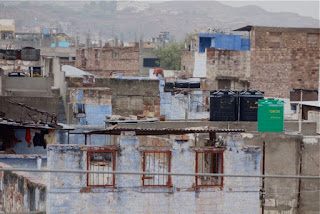 |
| Jodhpur roof tops in the rain |
It is raining when we arrive in Jodhpur but we ask to return to the old town for lunch. John and I slosh through puddles together and make our way back to Nirvana, our familiar roof top restaurant. Nirvana is deserted except for the two of us and the waiter seems surprised to have foreign customers in the inclimate weather. We sidestep leaks in canvas roof and peer down into the flooding market below. John sips on a hot drink; we eat hastily and wade through more puddles on our way back to our waiting car.
 |
| John drinking chai in the rain at Nirvana Restaurant, Jodhpur |
The domestic Jodhpur airport is small and we are met by an Incentive Destination liaison who, gives us our tickets and checks our baggage through to Jaipur. I purchased a brass fish padlock in the Jodhpur marketplace earlier and have neglected to put it in our checked luggage and when we go through security it is an issue. Security demands that we open the lock so that they may check inside the cavity of the locked fish. John struggles with the crude key and after several minutes is triumphant and we are allowed to pass through.
We have a close connecting flight between Deli and Jaipur. Coincidentally, a manager of Incentive Destinations is guiding another group that is boarding our same flight to Deli. I assume that he sees our Blue Elephant luggage tags because he greets us and assures us that there is plenty of time between flight connections and “Not to worry.” The flight to Deli takes less than an hour but when we land there is a delay in disembarking. John and I walk briskly through the terminal, following signs for connecting flights but the Deli airport is large and we must pass through another security check. Because of the assurance that there is “plenty of time”, we patiently wait in the long security line. Arriving at the front, we are chided for not informing them that we were short of time and the brass fish is again a “fishy” issue. This time John is able to open the lock quickly and we are hurried through, but when I look at the overhead signs for our gate number and see that our flight is flashing last call for boarding, I tell John to RUN! Gate 42 is at the far end of the terminal and in retrospect, I guesstimate that the gate was a ¼ mile away. I alternate jogging and fast walking and my adrenalin is rushing and my heart is pounding when I jog in for the finish. As I close in towards the gate, attendants wave at me to slow and to sit down to catch my breath but I decline, simply wanting to get onboard. John is approvingly surprised that I have made such good time. Apparently the gate attendants had asked John if his mother was “old” and he had said “yes,” so I surprised everyone!
When we arrive at the Jaipur airport we are met by an Incentive Destination liaison and transferred to our Heritage Hotel, the Mandawa Haveli, in the heart of the old city of Jaipur. Although this hotel may only be a 4 star, it is my favorite so far. 5 star tourist hotels may be more comfortable but they leave me wondering what country I am visiting? I have no doubt where I might be when the concierge opens the door to our room and we enter an expansive three room suite with scalloped archways and a bathroom fit for a maharaja.
 |
| Our Mandawa Haveli hotel room bath |
 |
| Our Mandawa Haveli hotel room suite |
The sheets and towels may not be plush, but I have just landed on my magic carpet.
It is late and I want to send e-mail home and as John showers, I walk to the 19th century hotels courtyard to connect to the 21st century internet. The weather changes abruptly and a strong wind whirls through the courtyard as I talk with Art via Skype. The keyboard to my computer is gritty with debris when the wind and rain abate and John and I remain hotel bound and dine in the confines of our hotels dining room.
Friday, January 18th – Jaipur
I hear rain during the night and it is raining lightly when we get up. At 8:30 A.M. our guide and driver arrive for our drive to the Amber Fort. Today’s guide is especially knowledgeable and easy to understand. On our way to the fort we stop to admire the salmon pink façade of Hawa Mahal, the Palace of the Winds. All of the public buildings, gateways, and palaces in Jaipur are painted this color, a color of welcome. This ornate and honeycombed palace is not much more than a narrow façade where the women of the royal household would go to watch processions on the street below.
 |
| Hawa Mahal, the Palace of the Winds |
The sun is breaking through the clouds when we arrive at the base of the Amber fort. There is already a line of tourists waiting for the elephant ride up to the fort. While our guide gets our tickets, John and I take turns waiting in the human line so that the other can take photos of the elephants milling within a stone courtyard, also waiting their turn for a fare.
 |
| Elephant passenger loading platform |
Our guide tells us that an elephant is only allowed 5 trips to the fort each day, or to work until 12:00 P.M; whichever comes first. Many of the elephants have colorfully painted heads and trunks and John reminds me that elephants love to be washed and painted, but only if they are painted well and that they can tell the difference I must have missed this important bit of trivia earlier on our trip. As we wait in line, we talk with some business majors from Harvard, share stories, and the line moves quickly. From a raised stone platform, John and I climb aboard our elephant. We are disappointed that it is not one of the painted ones but we scoot sidesaddle, onto the pristine white sheeted seat, atop our elephant. As touristy as this may be it is great fun and we laugh and sway with the rhythm of our pachyderm as it lumbers along the ancient stone road curving up towards the castle.
 |
| Elephant returning from the Amber Fort |
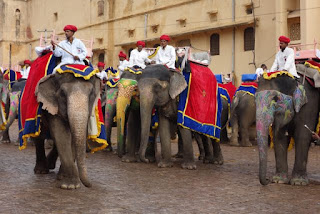 |
| Elephants waiting for a fare |
It starts to sprinkle slightly and I point to an ominous black cloud above and beyond. Several minutes later, the heavens open up in a deluge of rain. Our elephant guide is slow to hand us an umbrella, tucked underneath the padded blankets of our seat, and even slower to pull out the canvas tarp that other guides immediately threw over their passengers to protect them from the rain. We struggle to pull our feet up and under the protection of the tarp when suddenly the rain turns to hail. We are still laughing and having a wonderful time, but John’s only pair of shoes are soaked as well as his heavy cotton sweatshirt. The rain abates when we arrive at the vast castle courtyard and climb off of our elephant. Just before we get to the offloading platform our driver asks for a tip and I see signs that say “no tipping.” Nevertheless, I hand him 100 rupees, the equivalent of two dollars and he suggests that I give him more. I smile and decline telling him that our city guide told us that this was the expected amount. He smiles agreeably but I can’t blame him for trying. We dismount onto a stone platform, level with the elephants back and I see that the pristine white sheet is now smeared with mud.
 |
| Raining on the elephant parade |
 |
| Marty and John riding an elephant to the Amber Fort |
The Impressive Amber Fort was built in 1728 and is a combination of Rajput and Mughal architecture. We are in the vast and formal walled courtyard. The fortress is surrounded on three sides by mountains and the ancient guard walls and towers still stand proudly. The panoramic views of Jaipur city, a jumble of indistinct pink and blue block buildings, are stunning in the valley below. A manmade lake with a center island is at the base of the fortress wall. The island is a formal Mughal garden, used as a pleasure island for Royalty in time of peace. During periods of siege, dams could be opened and the water would flood into the valley, damping the gunpowder and hindering the progress of the invading forces.
 |
| City view of Jaipur in the valley beyond |
 |
| Immense Amber Fort Courtyard and surrounding mountains |
 |
| Island Mughal Garden |
We enter an immense open courtyard with a raised gallery of scalloped arcades, designed for large political gatherings.
 |
| Covered arcade, Amber Fort |
 |
| Covered gallery, Amber Fort |
The most beautiful of the courtyards is the stunning, Sheesh Mahal, the hall of mirrors. This courtyard and hall was designed for pleasure alone. The pale marble facade sparkles with thousands of convex mirrors and intricate mosaics. An expansive Mughal garden is the focal point of this pleasurable courtyard and marble aqueducts and trimmed hedges geometrically define the garden. Our guide tells us that a drip system was engineered to cool the hall during the extreme heat of the summer and that the fountains were anointed with fragrant essential oils that circulated in the garden.
| Mirror Detail |
 |
| John at the Sheesh Mahal, Hall of Mirrors |
 |
| Passage way – Sheesh Majal |
 |
| Mughal gardens – Sheesh Majal |
We visit the private courtyards for the Maharaja, his 12 wives and the castle servants and guards. A maze of cloistered corridors, are designed to lead from each of the wives quarters to the Kings chambers. The narrow corridors are designed so that when the King sent a servant girl to fetch one wife, so that his other wives would not know.
 |
| Detail of pierced stone window |
 |
| Pierced stone window |
When we leave the palace we see a snake charmer, charming the tourists more than his cobra. The snake’s fangs have been removed and I surmise it is not a very happy snake. I hope our tips will afford the snake a fat mouse. John kneels down beside the young man to pet the snake and I take the expected photos but when it is my turn, the snake has had enough and hisses at me. Instinctively, I pull back although I have little fear of snakes. The handsome snake charmer puts his snake back into its covered basket and waits for the next tourist to bite.
 |
| John and the Snake Charmer |
 |
| Snake Charmer and Cobra |
 |
| Marty and the Snake Charmer |
 |
| Amusing Peacock Chairs |
We visit the Jantar Mantar, a bazar, outdoor, astrological observatory built in the 18th century by the Maharaja Jai Singh. This world heritage site would be best visited on a sunny afternoon but the sky threatens more rain. John is still wet and cold from the earlier downpour during our elephant ride to the Amber fort. He squeezes into a dry jacket of mine and warms slightly. Fortunately, we have intermittent moments of sunshine so that we are able to see the demarcations of shadows and to some degree, understand the concept of this remarkable astrological site. Unfortunately, the battery in my camera flashes “exhausted” and shuts down. These are the only two photos I have of this remarkable site.
 |
| Monumental Sundial at Jantar Mantar |
 |
| Astrological demarkations of the heavens |
The Maharaja contracted scientist from around the country to help build this observatory. There are two monumental sundials with curved polished marble extensions, carefully delineated with marks dividing the hours into minutes and into second intervals. The smaller of the two must be 20 feet high with two minute accuracy, and the larger one, 10 times the height of the first has a 2 second accuracy. 12 smaller astrological sundials chart the individual signs of the zodiac and since January is the sign of Capricorn, this dial only, is showing a shadowed demarcation. There are numerous other monumental astrological devices that our guide explains to us and I think of Dianne Wooden, our Astrophysicist friend, and wished she were here to share and explain this site to us. My camera battery dies here and for the rest of the day, we use Johns cell phone to take photos.
The City Palace, the former royal residence is across the street from the observatory. I am reaching palace saturation, but each fort and palace offers something unique and remarkable. The highlight of this palace is an interior courtyard with 4 striking interior doorways, representing winter, summer, spring and fall. Three stunning peacocks crown the massive summer doorway. The bas relief peacocks are painted hues of brilliant blues, greens and gold into the scalloped, ornately frescoed archway. Our visit to the costume gallery is quick but the armory museum has a wonderful collection of weapons, all of them intricately engraved, carved and inlaid; pieces of lethal jewelry.
Our city tour is at an end and our guide and driver expect to take us back to the safety of the Mandawa Haveli hotel but John and I ask to be let out in the old town. It is nearly dark and both guide and driver are concerned for our safety but we are insistent and assure them that we will be fine. We walk along the main market street, first in one direction and then cross over and walk back on the other side. It is wonderful to be on our own exploring the market by night. The tiny shops are brightly lit and crammed with interesting goods. One stretch of shops sells only galvanized kitchen goods, another stretch sells automotive parts and another area of shops sells brass Hindu Deities. John pokes into several brass figurine shops and after much haggling and decision making, he buys an assortment of bronze deities; Ganesha, Shiva, Lakshmi, Vishnu and Hanuman. I am John’s banker and our cash is running low and I look for an ATM, but the first one I come to is out of money and a second one is out of order. I am a little worried since our rupees are going quickly and I will need to find a working ATM before we drive to Agra in the morning. We guess that we are only half a mile from our hotel and the shops continue to be interesting so instead of taking a tut-tut, we decide to walk back through the ancient city gate to our hotel. We turn left after the gate and walk several long and rather dark blocks until we see our hotel. We have a second, non memorable, but not overly expensive, dinner in the hotel restaurant and retire to our palatial room for the night.